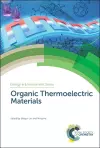
Organic Thermoelectric Materials
2 contributors - Hardback
£169.00
Dr. Zhiqun Lin is currently Professor of Materials Science and Engineering at the Georgia Institute of Technology. He received his PhD degree in Polymer Science and Engineering from University of Massachusetts, Amherst in 2002. He did his postdoctoral research at University of Illinois at Urbana-Champaign. His research interests include polymer-based nanocomposites, block copolymers, conjugated polymers, quantum dots (rods, tetrapods and wires), functional nanocrystals (metallic, magnetic, semiconducting, upconversion and thermoelectric) of different architectures, solar cells (perovskite solar cells and dye sensitized solar cells), batteries, hydrogen generation, thermoelectric materials and devices, hierarchically structured and assembled materials, and surface and interfacial properties. He has published more than 220 peer reviewed journal articles (with an h-index of 61), 10 book chapters, and 4 books. Currently, he serves as an Associate Editor for Journal of Materials Chemistry A, and an editorial advisory board member for Nanoscale. He is a recipient of Frank J. Padden Jr. Award in Polymer Physics from American Physical Society, an NSF Career Award, a 3 M Non-Tenured Faculty Award, and an invited participant at the National Academy of Engineering’s 2010 US Frontiers of Engineering Symposium. He became a Fellow of Royal Society of Chemistry in 2014 and a Japan Society for Promotion of Science (JSPS) Fellow in 2015. Dr. Ming He received his B.S. in Materials Science and Engineering from East China University of Science and Technology in 2005, and received his Ph.D. in Polymer Chemistry and Physics from Fudan University in 2011. He was a visiting student at Iowa State university (2009-2011). He worked as a Postdoctoral Fellow at Fudan University (2011-2013) and Georgia Institute of Technology (2013-2017). In July 2017, he became a Research Scientist at Georgia Institute of Technology. His research interests include conjugated polymers, organic-inorganic hybrid semiconductors, solar cells, and thermoelectricity.